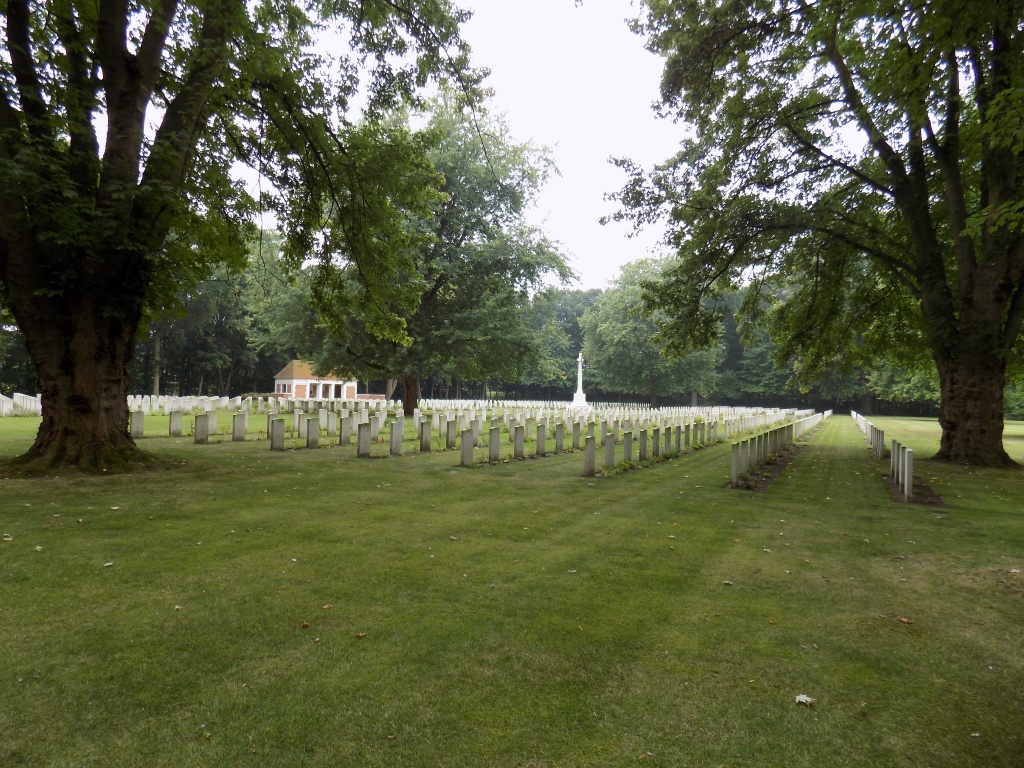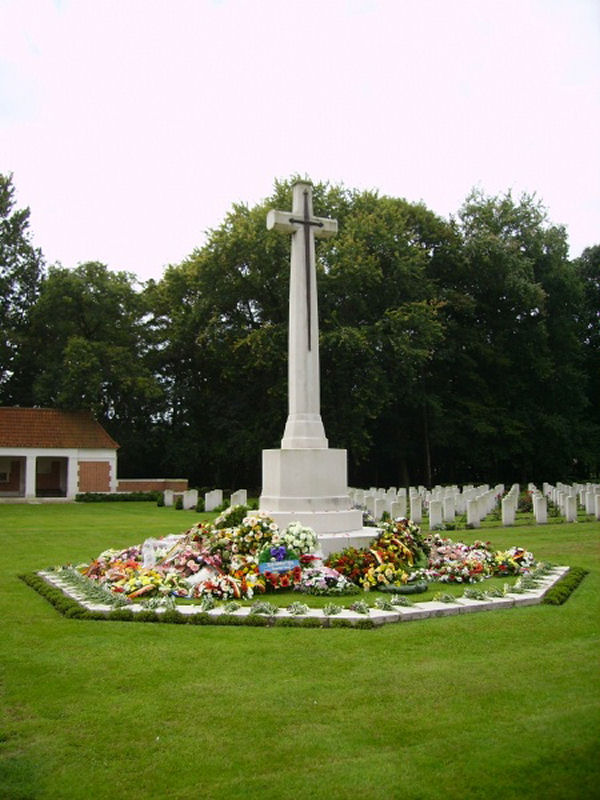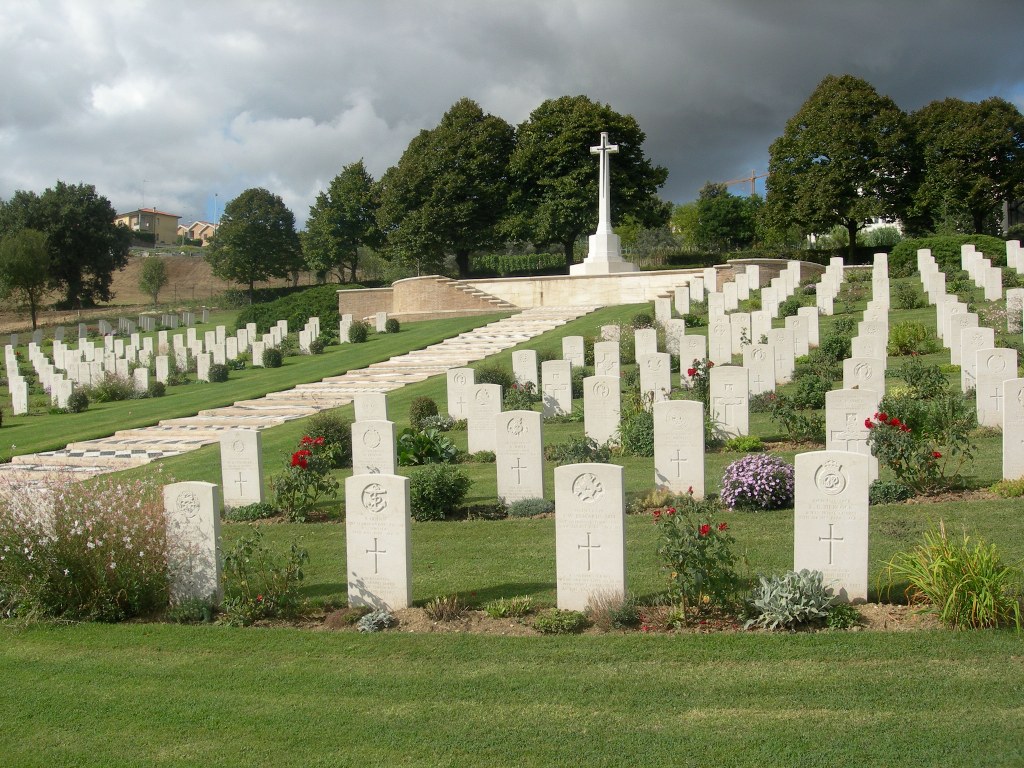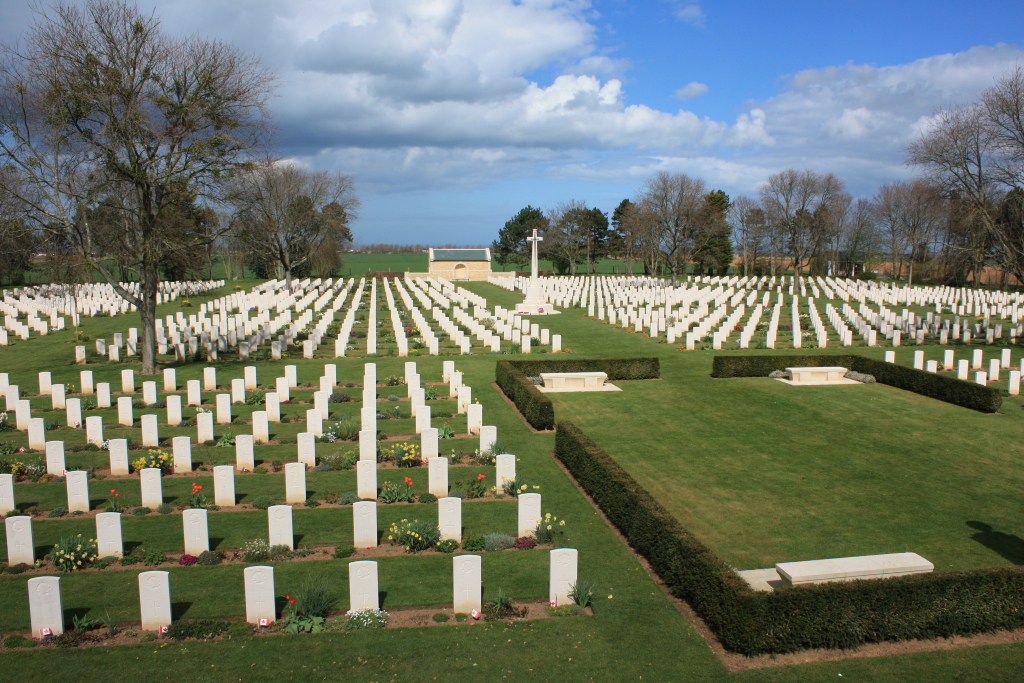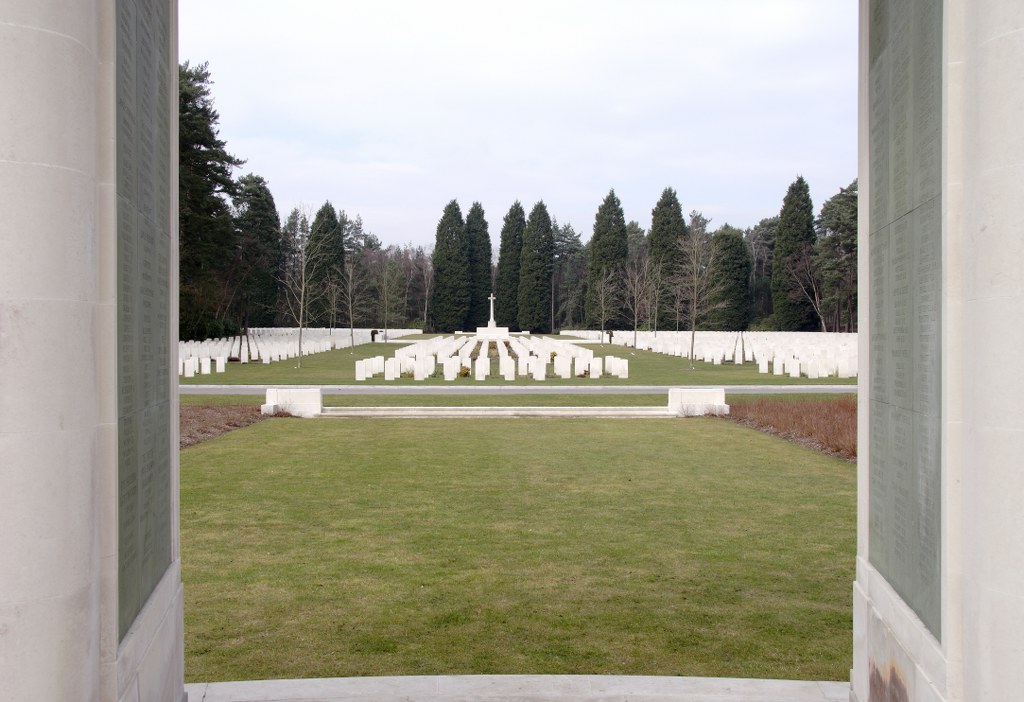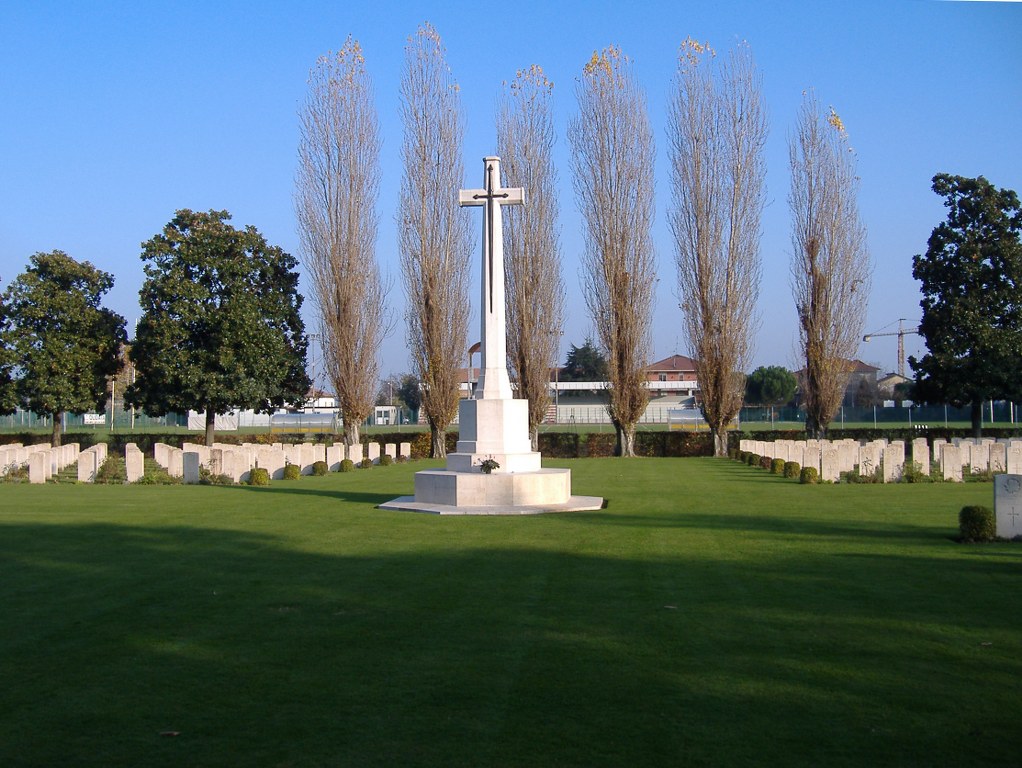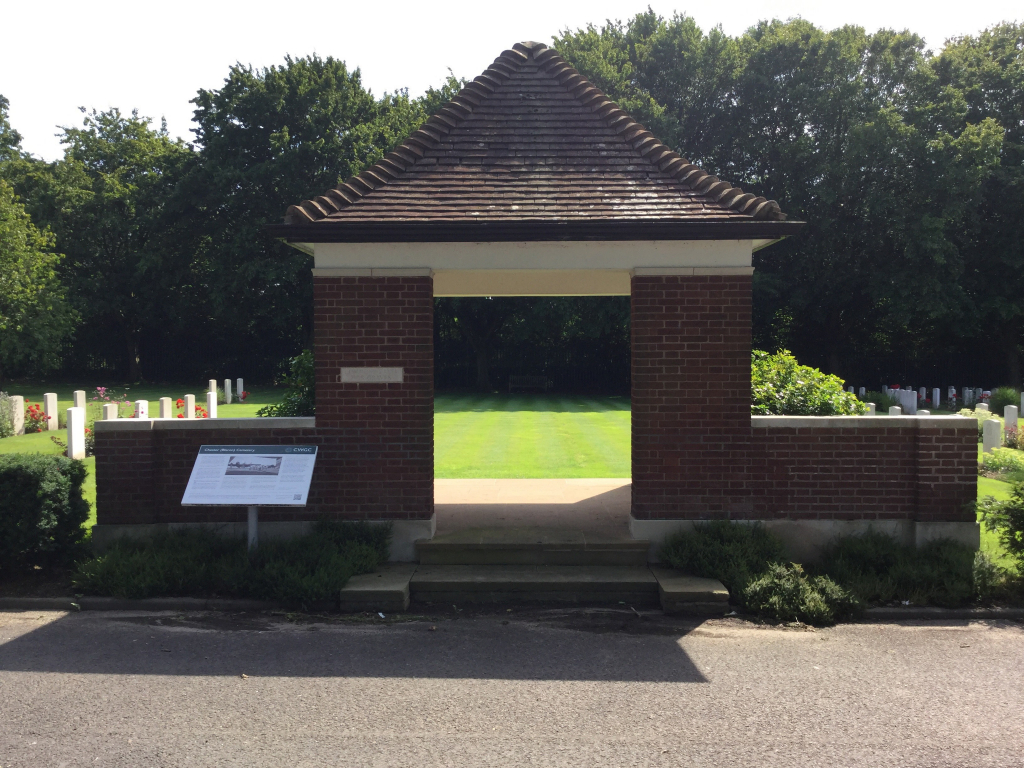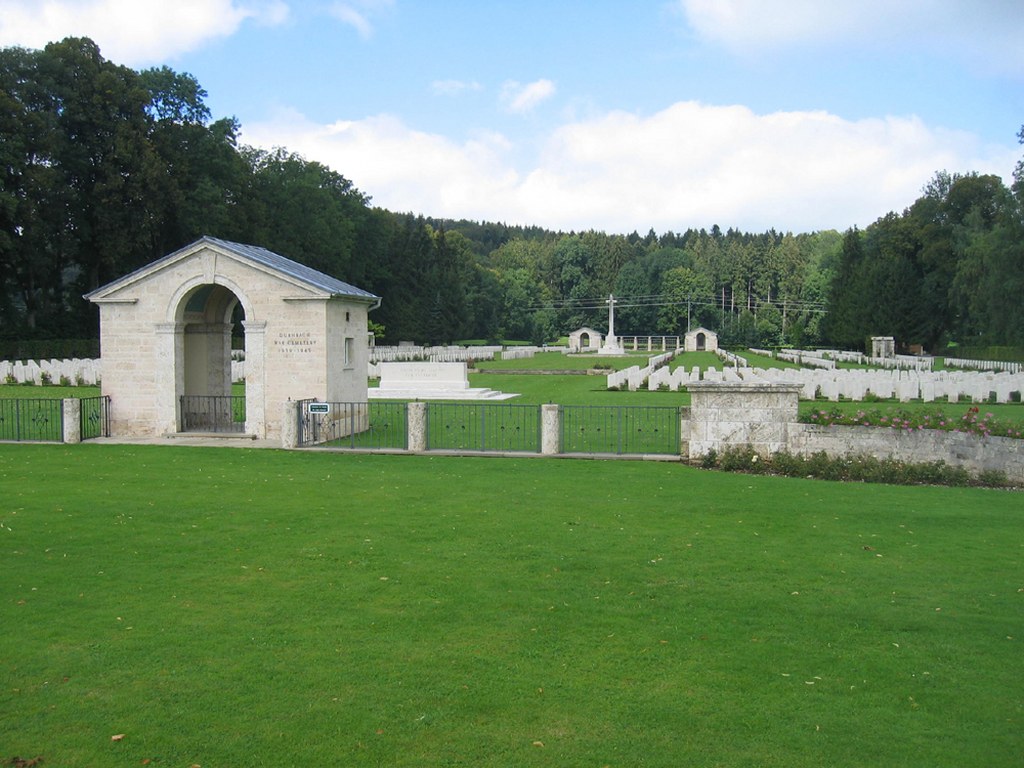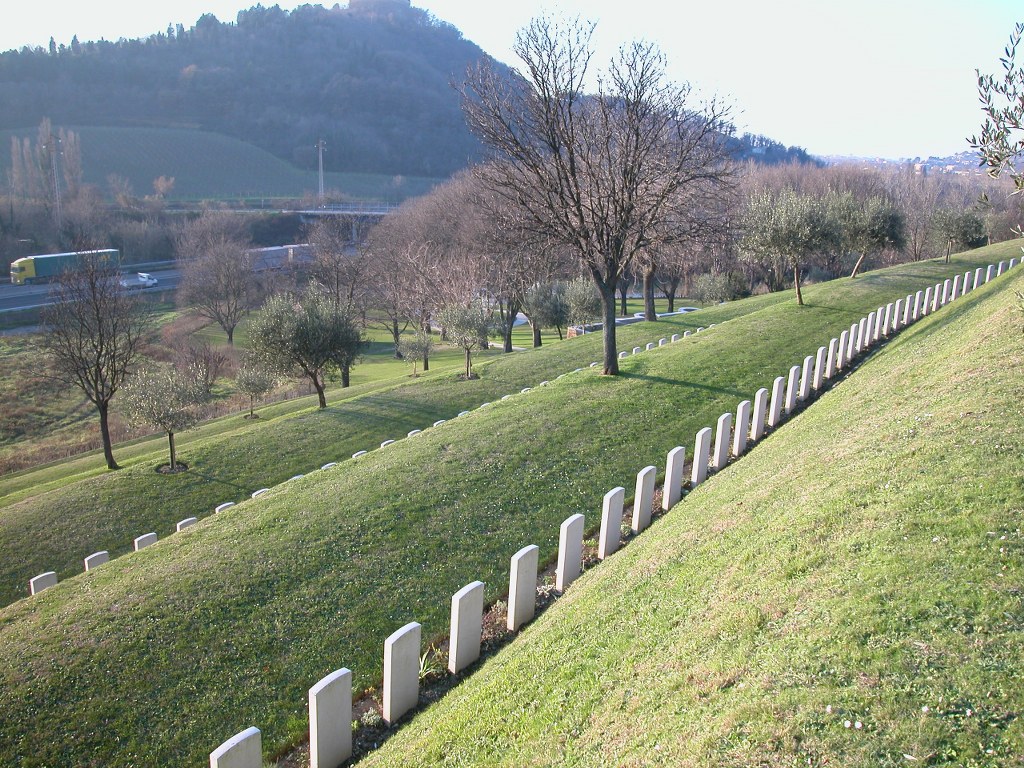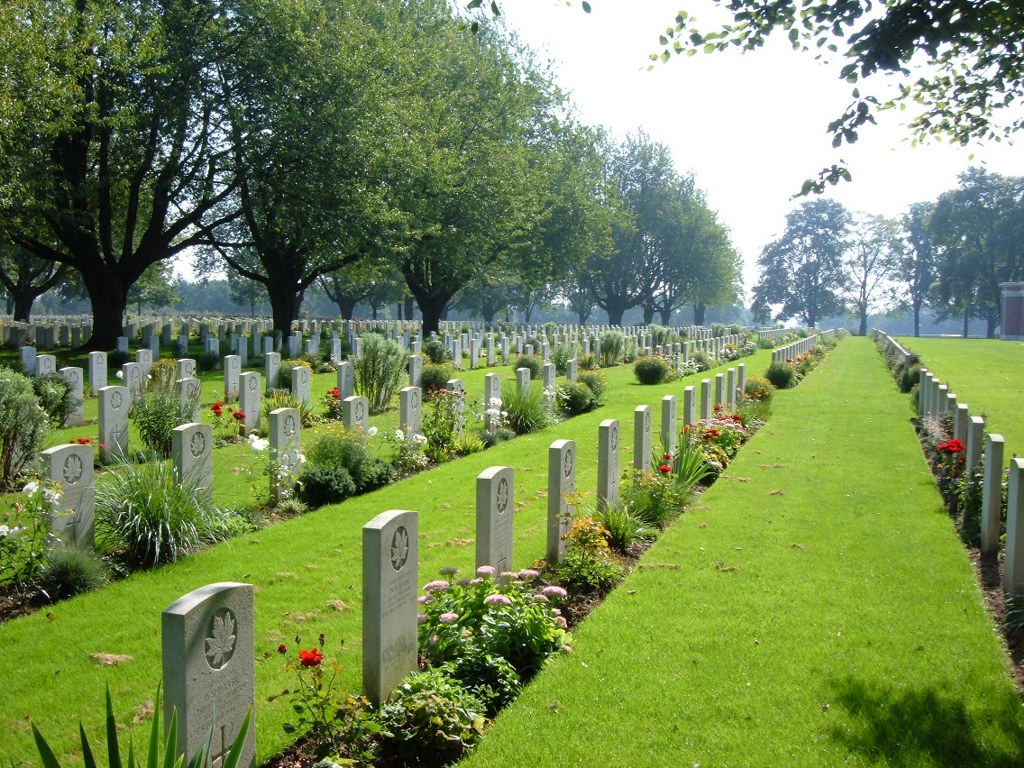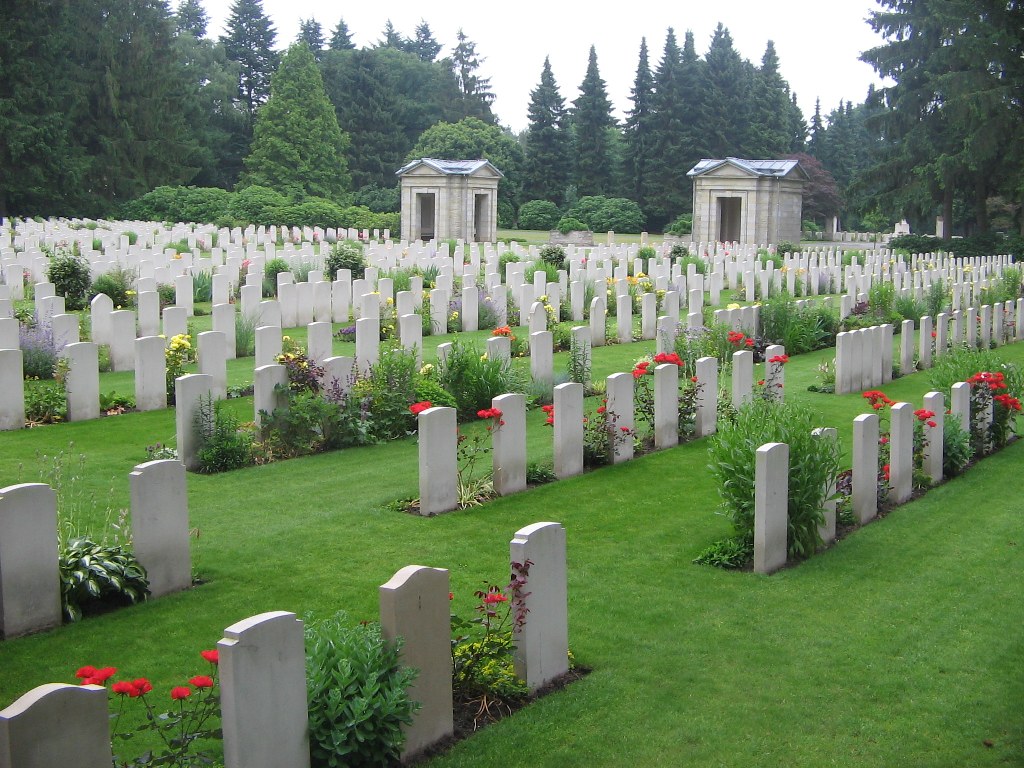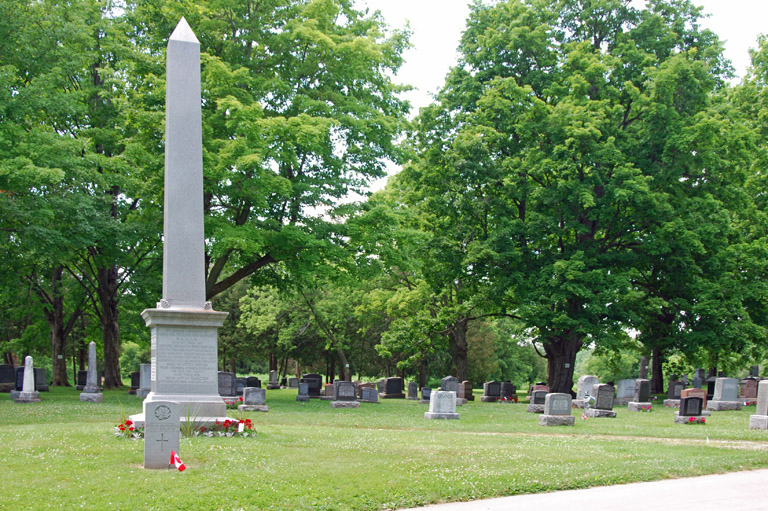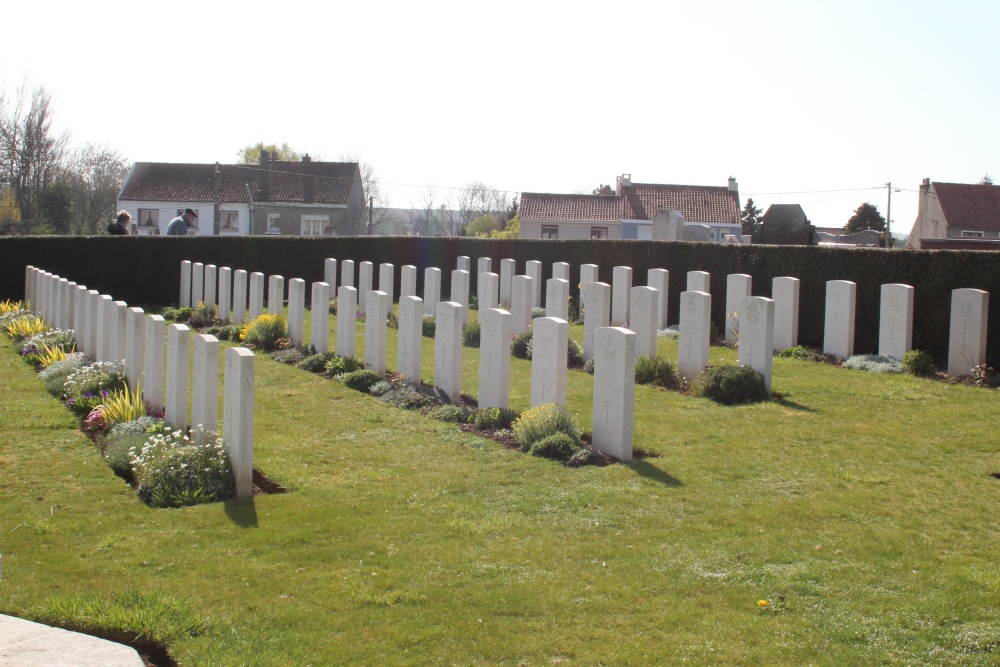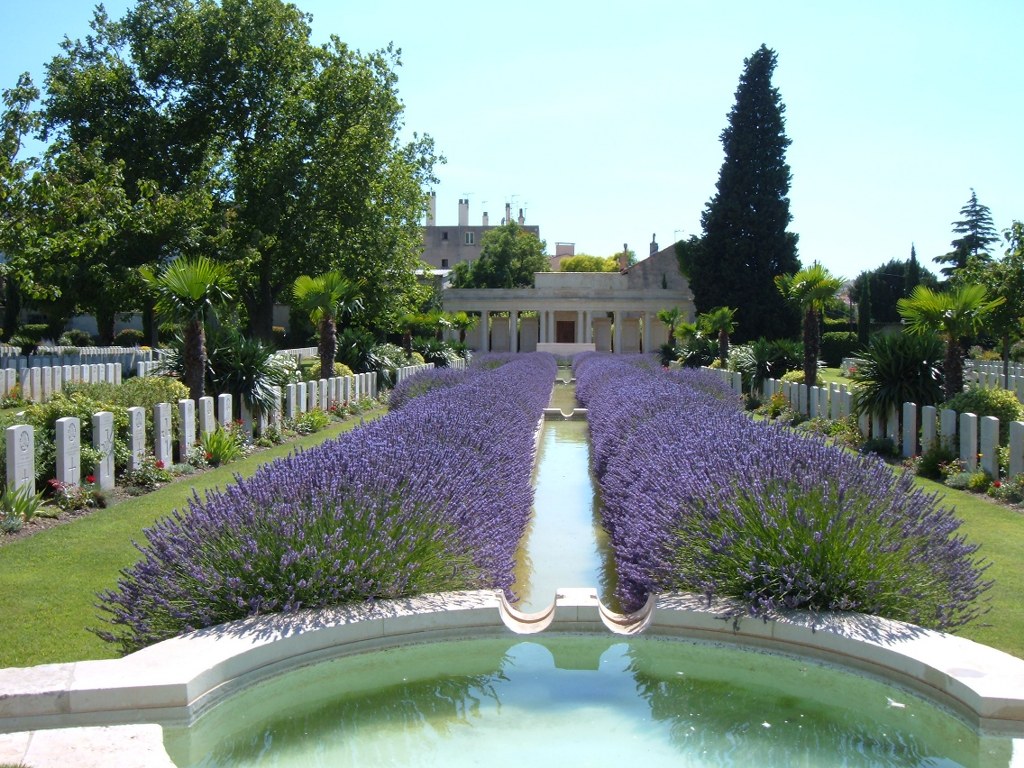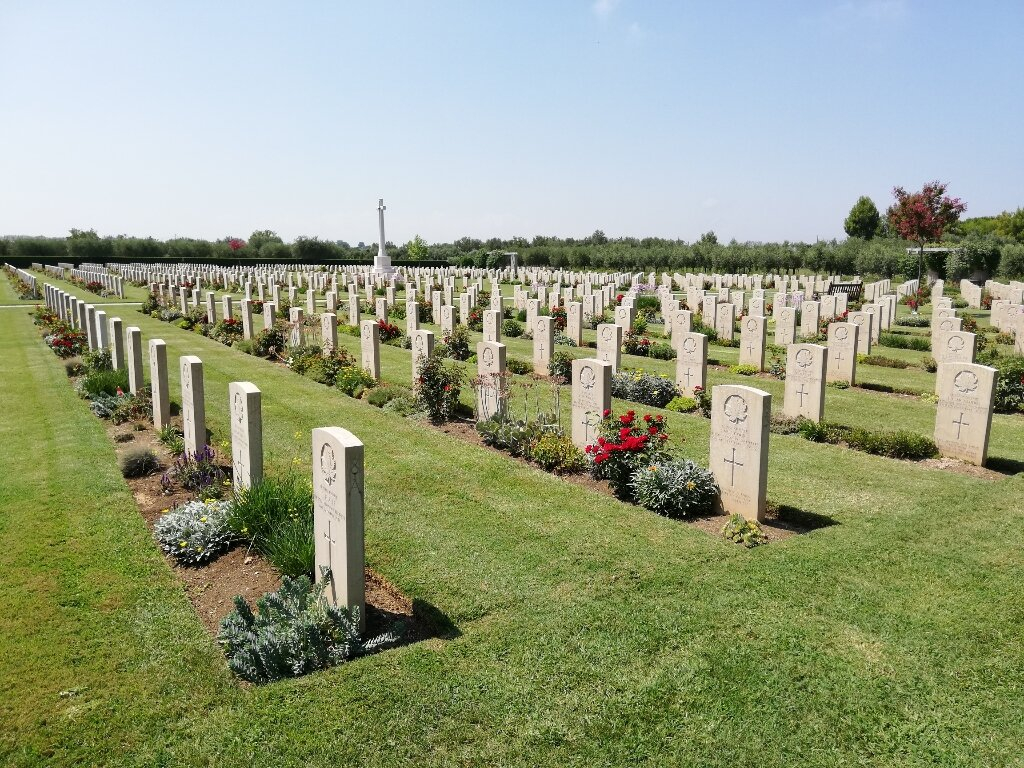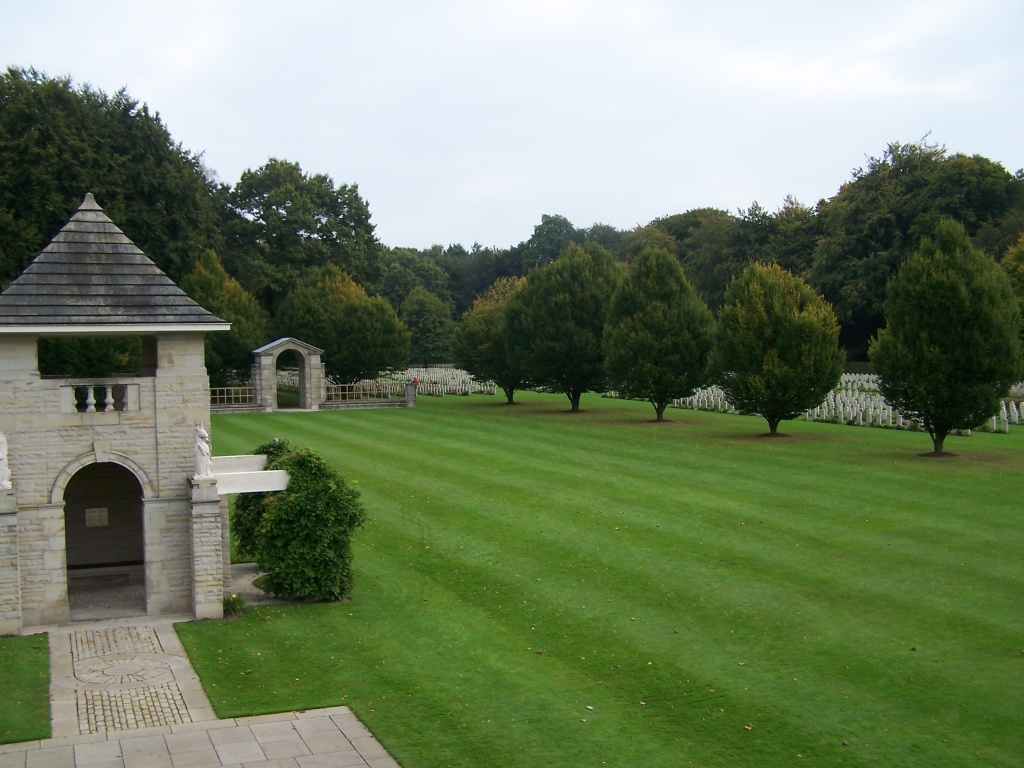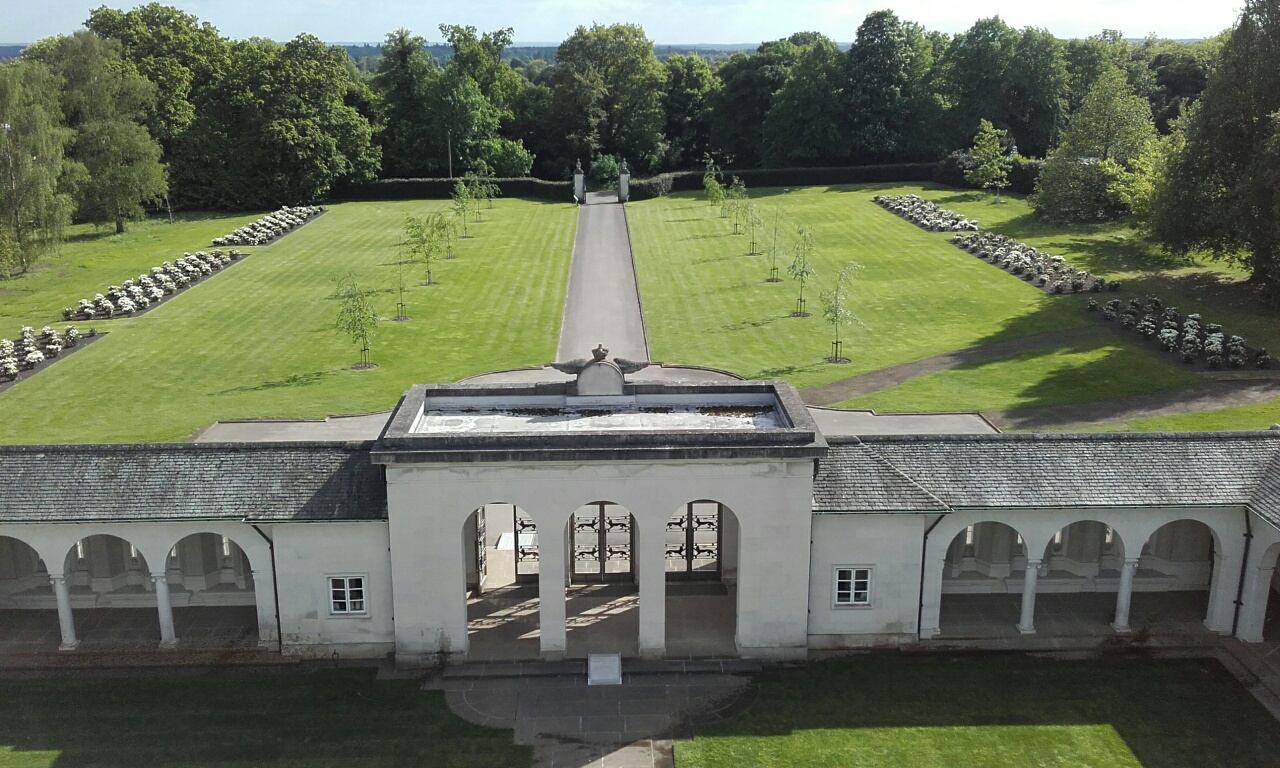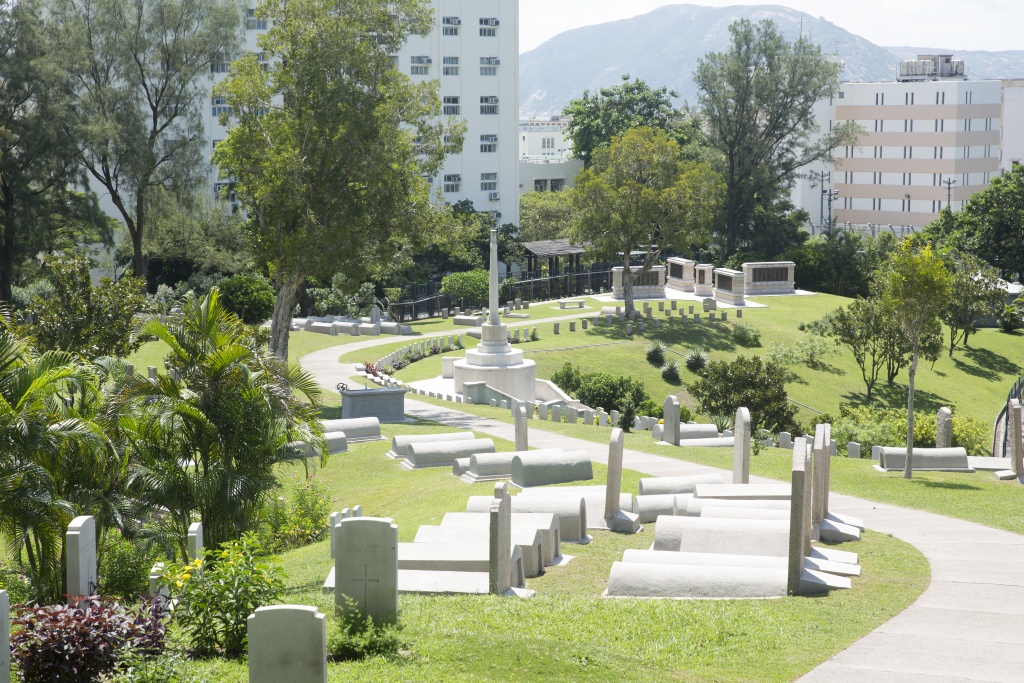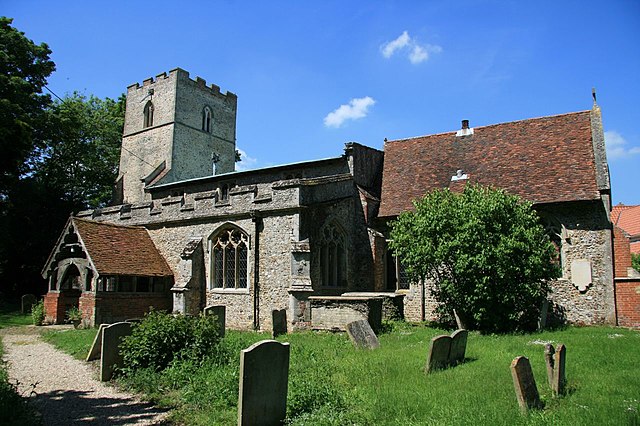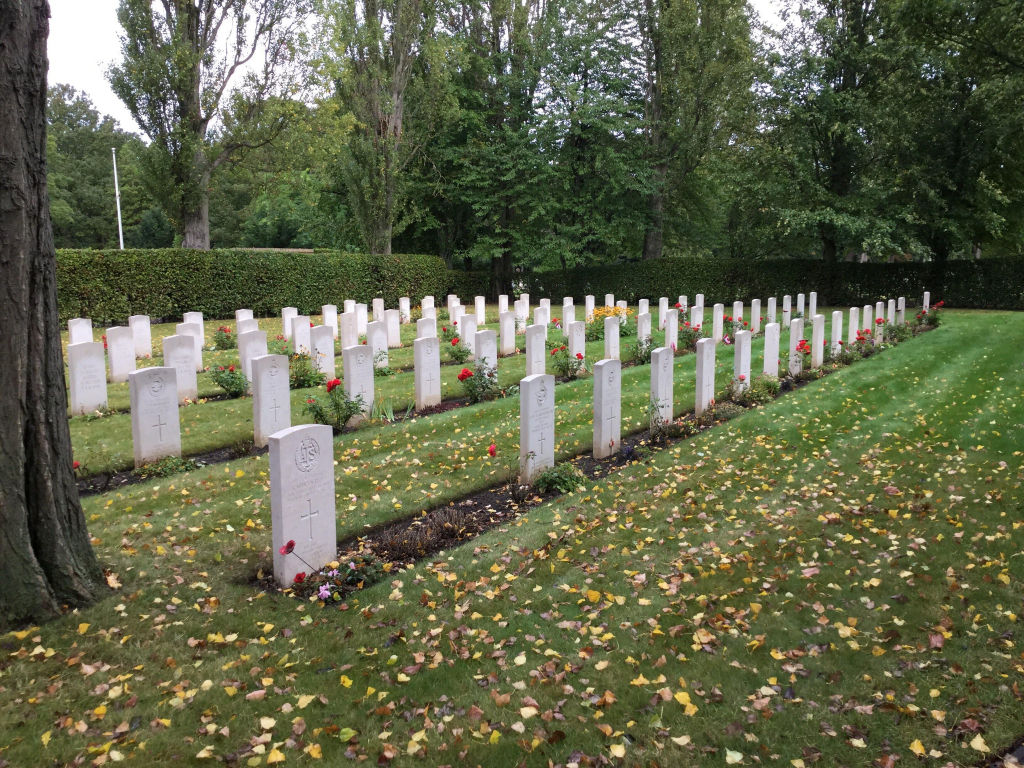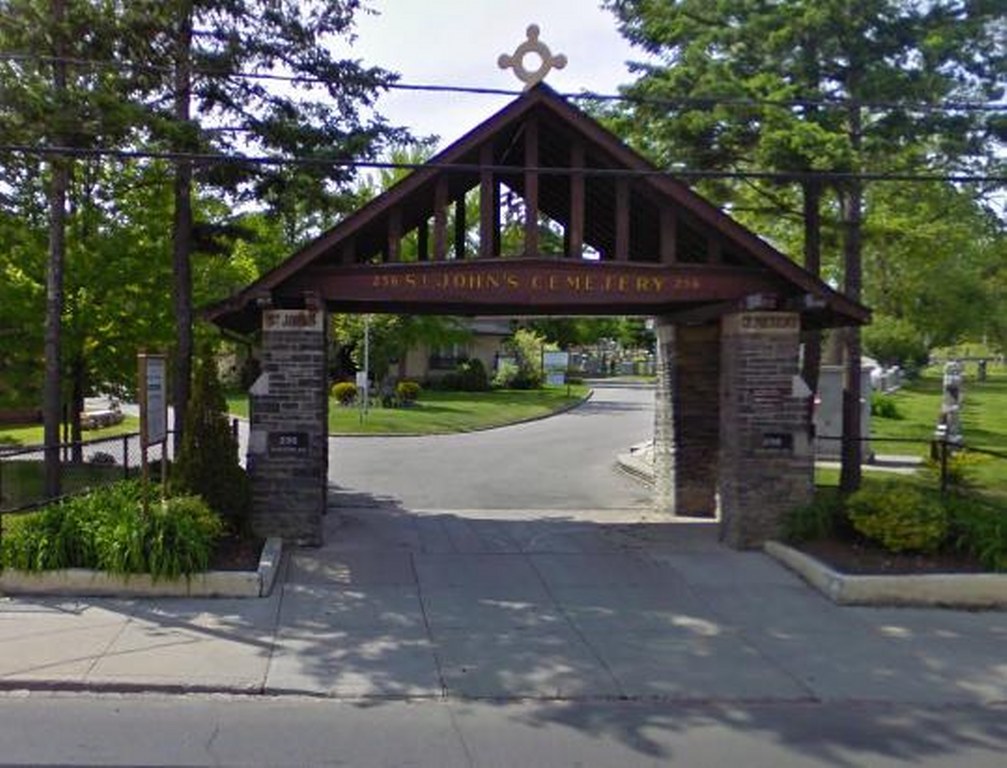Adegem Canadian War Cemetery, Belgium.
Adegem Canadian War Cemetery is located midway between Brugge (17 km) and Ghent (26 km) on the N9 which connects the two towns. From Brugge, Adegem is approached via Sijsele and Maldegem. On reaching Adegem, the cemetery is located on the Prins Boudewijn Laan, on the right hand side of the N9. In the last week of September 1944, the Allies held the city of Antwerp, but the Germans held both shores of the Scheldt estuary, so that the port of Antwerp could not be used. The task of clearing the southern shore of the estuary was allotted to the 3rd Canadian Division, aided by the 4th Canadian Armoured Division and the 52nd Division. Their operations lasted from October until the beginning of November 1944. By 3rd November the Germans had been cleared from the north-west corner of Belgium and the south shore of the Scheldt was free. There had been fierce fighting for two weeks for the crossing of the Leopold Canal. The majority of the men buried at Adegem died during the operations for the clearance of the south bank of the Scheldt; but many Canadians who lost their lives elsewhere in Belgium were also brought here for burial.Ancona War Cemetery, Italy.
On 3 September 1943 the Allies invaded the Italian mainland, the invasion coinciding with an armistice made with the Italians who then re-entered the war on the Allied side. Following the fall of Rome to the Allies in June 1944, the German retreat became ordered and successive stands were made on a series of defensive positions known as the Trasimene, Arezzo, Arno and Gothic Lines. The cemetery at Ancona reflects the Allied progress up the Adriatic coast in August and September 1944. The cemetery site was chosen in September and graves were brought in from a wide area round about, extending from Pescara, 80 kilometres farther south, to Pesaro, over 48 kilometres north of Ancona. They include those of casualties from the first attacks on the eastern sector of the German defensive Gothic Line, near Fano and Pesaro, at the end of August and early in September, plus some 80 casualties from the L'Aquila bombing incident that occurred in December 1943. Ancona itself had been taken by the Poles on 18 July 1944 and, being little touched by the war, served as the main port for supplies for the attack on the Gothic Line and for the final break through the following spring at Argenta. Ancona War Cemetery contains 1,019 Commonwealth burials of the Second World War. The ANCONA WAR CEMETERY lies in the rural locality of Tavernelle, in the Commune and Province of Ancona, 3 kilometres south of the town of Ancona. The ANCONA WAR CEMETERY is reached from the town by following the Varono-Camerano road up the hill past the Ancona Communal Cemetery on the left. Continuing straight down the hill for about 200 metres, visitors will find the War Cemetery on the right. Alternatively, leave the Austostrada at Ancona Sud and take the SS16 towards Ancona. After approximately 3 kilometres (via Pietro Filonze) turn right to pass in front of the wholesale fruit markets; pass under the railway line and at the next junction turn left. The War Cemetery is found after several kilometres on the left shortly after a FINA petrol filling station. This route is signposted.Beny-sur-Mer, Normandy
Beny-sur-Mer Canadian War Cemetery is about 1 kilometre east of the village of Reviers, on the Creully-Tailleville-Ouistreham road (D.35). Reviers is a village and commune in the Department of the Calvados. It is located 15 kilometres north-west of Caen and 18 kilometres east of Bayeux and 3.5 kilometres south of Courseulles, a village on the sea coast. The village of Beny-sur-Mer is some 2 kilometres south-east of the cemetery. The bus service between Caen and Arromanches (via Reviers and Ver-sur-Mer) passes the cemetery. It was on the coast just to the north that the 3rd Canadian Division landed on 6th June 1944; on that day, 335 officers and men of that division were killed in action or died of wounds. In this cemetery are the graves of Canadians who gave their lives in the landings in Normandy and in the earlier stages of the subsequent campaign. Canadians who died during the final stages of the fighting in Normandy are buried in Bretteville-sur-Laize Canadian War Cemetery. There are a total of 2,048 burials in Beny-sur-Mer Canadian War Cemetery. There is also one special memorial erected to a soldier of the Canadian Infantry Corps who is known to have been buried in this cemetery, but the exact site of whose grave could not be located.Bergen-op-Zoom Canadian War Cemetery, Netherlands.
Bergen-op-Zoom Canadian War Cemetery is located 39 Km north west of Antwerp and 19 Km after passing the Border into the Netherlands. The N11 connects Antwerp to Bergen op Zoom via Kapellen, Pulte, Hoogerheide and finally on to Bergen op Zoom. On reaching Bergen op Zoom railway station turn right onto the Stationsplein and after 200 M turn right onto the Bredastraat. Follow this road for 500 M where it becomes Wouwsestraatweg and carry straight on for 2.5 kilometres. The street name has now changed to the Ruytershoveweg and the Bergen-op-Zoom Canadian War Cemetery can be found on the left of this street. Steps into cemetery (not suitable for wheelchairs).Berlin 1939-1945 War Cemetery
The BERLIN 1939-1945 WAR CEMETERY is in the district of Charlottenburg, 8 kilometres west of the city centre, on the south side of the Heerstrasse. From Theodor Heuss Platz in the district of Charlottenburg near the exhibition hall complex and next to the olympic stadium, follow signs for Spandau, proceeding along the Heerstrasse. The Cemetery lies on the Heerstrasse on the left hand side of the road and 3 kilometres from Theodor Heuss Platz. Visitors should drive beyond the BERLIN 1939-1945 WAR CEMETERY to the traffic lights, then turn left directly onto a small one way street running parallel to the Heerstrasse. The Cemetery entrance is on this small one way road.Bretteville-sur-Laize Canadian War Cemetery, France.
This cemetery lies on the west side of the main road from Caen to Falaise (route N158) and just north of the village of Cintheaux. Bretteville-sur-Laize is a village and commune in the department of the Calvados, some 16 kilometres south of Caen. The village of Brettevillelies 3 kilometres south-west of the Cemetery. Buried here are those who died during the later stages of the battle of Normandy, the capture of Caen and the thrust southwards (led initially by the 4th Canadian and 1st Polish Armoured Divisions), to close the Falaise Gap, and thus seal off the German divisions fighting desperately to escape being trapped west of the Seine. Almost every unit of Canadian 2nd Corps is represented in the Cemetery. There are about 3,000 allied forces casualties of the Second World War commemorated in this site.Brookwood Military Cemetery, Surrey UK.
Brookwood is 30 miles from London (M3 to Bagshot and then A322). The main entrance to Brookwood Military Cemetery is on the A324 from the village of Pirbright. Brookwood Military Cemetery is owned by the Commonwealth War Graves Commission and is the largest Commonwealth war cemetery in the United Kingdom, covering approximately 37 acres. In 1917, an area of land in Brookwood Cemetery (originally The London Necropolis) was set aside for the burial of men and women of the forces of the Commonwealth and Americans, who had died, many of battle wounds, in the London district. This site was further extended to accommodate the Commonwealth casualties of the Second World War, and American, Belgian, Czech, Dutch, French and Polish plots containing the graves of Allied casualties. There are also German and Italian plots where prisoners of war lie buried.Cassino War Cemetery, Italy.
Cassino War Cemetery lies in the Commune of Cassino, Province of Frosinone, 139 kilometres south-east of Rome. It is situated in the valley of the River Liri immediately below the southern spurs of the central Apennines. Above it at a distance of one kilometre is the dominating hill on which stands the Abbey of Monte Cassino, founded by St. Benedict in the year 529 on the site of an ancient temple of Apollo. If approaching the CASSINO WAR CEMETERY by road, follow the Highway A2 from Rome to Naples and leave it at the Cassino exit. After passing the pay booths, follow the sign for Cassino. At the traffic lights, after a block of flats, turn right towards the locality of S. Angelo and the CWGC signs will then be seen.Cesena War Cemetery, Italy
Cesena War Cemetery lies in the Commune of Cesena, in the Province of Forli, and is situated one kilometre north-east of Cesena railway station on the provincial road to Cervia (Route No.71 bis). If exiting at Cesena from the highway, the sign will be seen for the Cemetery. From the other direction in Cesena, follow the sign to Rimini and then Cervia and the Cemetery will be found on the right. On 3 September 1943 the Allies invaded the Italian mainland, the invasion coinciding with an armistice made with the Italians, who then re-entered the war on the Allied side. Following the fall of Rome to the Allies in June 1944, the German retreat became ordered and successive stands were made on a series of defensive lines. In the northern Appenine mountains the last of these, the Gothic Line, was breached by the Allies during the Autumn campaign and the front inched forward as far as Ravenna in the Adratic sector, but with divisions transferred to support the new offensive in France, and the Germans dug in to a number of key defensive positions, the advance stalled as winter set in. Most of those buried in this cemetery died during the advance from Rimini to Forli and beyond in September-November 1944, an advance across one flooded river after another in atrocious autumn weather. The cemetery site was selected in November 1944 and burials were brought in from the surrounding battlefields. Cesena War Cemetery contains 775 Commonwealth burials of the Second World War. It is permanently open and may be visited at any time; outside the working hours of the local gardening staff, it will be unmanned.Chester (Blacon) Cemetery Cheshire. UK.
Chester (Blacon) Cemetery is just over a mile northwest of Chester city centre. Amongst the several thousand civilian burials are over 450 Commonwealth war graves of the Second World War and almost 100 servicemen of other nations. All six of our member governments are represented here, as are the Netherlands, Poland, Russia, Italy and Germany. These graves attest to the diverse and international nature of service and sacrifice during the Second World War. The Blacon War Cemetery plots set aside for service burials early in the war remained largely unused until mid-1943 when the larger of the two plots, plot A, was designated as one of six Royal Air Force Regional Cemeteries and the Air Ministry ordered that all Dominion air force dead were to be buried into one of these, unless they had family resident in the UK who wished to arrange private interment. Just under 400 of those we commemorate here today are air force dead, over 191 of them from the Royal Canadian Air Force alone.Courances Communal Cemetery, France
Courances is a village 48 kilometres south-east of Versailles. The Communal Cemetery lies on the east side of the village on the by-road leading south of the road to Melun. History Information: Near the monument in the centre of the cemetery are the graves of 6 airmen, 5 belonging to the Royal Air Force and 1 to the Royal Canadian Air Force.Dieppe Canadian War Cemetery, Hautot-sur-Mer, Seine-Maritime, France.
The Dieppe Raid of 18-19 August 1942 was the first large scale daylight assault on a strongly held objective on the Continent since the Allied withdrawal of 1940. The objectives of the raid were the destruction the Dieppe defences and neighbouring radar and aerodrome installations, the raiding of a German divisional headquarters close by and the capture of prisoners. The largely Canadian military force undertook the main assault on Dieppe itself, with flanking assaults by Commando units and additional Canadian battalions to the east and west of the town intended to neutralise batteries that commanded the direct approach. Support was provided by more than 250 naval vessels and 69 air squadrons. Only the assaulting parties on the extreme flanks came within reasonable reach of their ambitious objectives and casualties were very heavy, with more than 3,600 of the military force of 6,100 killed, wounded, missing or captured. Naval casualties numbered 550. Many of those who died in the raid are buried at Dieppe Canadian War Cemetery, where 948 Commonwealth servicemen of the Second World War are now buried or commemorated, 187 of which are unidentified. There are 7 non Commonwealth and 2 non World War burials here. Other casualties of the raid are at Rouen, where some of the wounded were taken to hospital. Dieppe Canadian War Cemetery, designed by Philip Hepworth, was the first new cemetery of the 1939-45 war to be completed in 1949. From the centre of Dieppe take the Avenue Gambetta and Avenue des Canadiens. Head along the N27 out of Dieppe in the direction of Rouen until the first roundabout where there is a Commonwealth War Graves Commission sign. Go across the roundabout and continue until you reach a second roundabout. Take the first turning right where there is another CWGC sign. Continue until Chemin des Jonquilles, a road on the left. The Dieppe Canadian War Cemetery is on the right of this road and is clearly visible.Durnbach War Cemetery, Germany
Durnbach is a village 16 kilometres east of Bad Tolz, a town 48 kilometres south of Munich. Durnbach War Cemetery is 3 kilometres north of the village Gmund am Tegernsee. Using the A8 from Munich, turn off at the junction Holzkirchen, taking the 318 road in the direction of Gmund am Tegernsee. At the crossroads with the 472, turn left in the direction of Miesbach. The cemetery is situated approximately 500 metres on the left from the 318/472 crossroads.Gradara War Cemetery, Italy.
Gradara War Cemetery is situated in the Commune of Gradara in the Province of Pesaro, at a distance of about 1.5 kilometres from the shores of the Adriatic. To reach the GRADARA WAR CEMETERY from Highway A14 (Bologna-Taranto), exit at Cattolica, which is the nearest town and a seaside resort. The Cemetery is on the main road 5 kilometres south west of the town. The cemetery occupies a unique position on a hillside which was terraced for agriculture, each row of graves taking up one terrace. The site for the cemetery was chosen in November 1944 and it contains the graves of casualties incurred during the advance from Ancona to Rimini (which broke the Gothic Line) and in the heavy fighting arounGroesbeek Canadian War Cemetery Netherlands
Groesbeek is located 10 km south east of the town of Nijmegen and close to the German frontier. The Groesbeek Canadian War Cemetery is 3 km north of the village and 1500 metres east of the main road to Nijmegen. On leaving the A73 motorway at the junction OverasseltMookGroesbeek follow directions to Mook. Follow direction signs towards Mook War cemetery. After passing Mook War cemetery continue to the village of Groesbeek to a set of traffic lights. Turn left at the lights onto Dorpstraat passing through Groesbeek. The road name then changes to Molenweg. A Commonwealth War Graves Commission direction sign indicates the right hand turning from Molenweg onto the ZevenHeuvelenweg. The Groesbeek Canadian War Cemetery is located on the right hand side, about 1 km after entering this road. On the Memorial in the Canadian War Cemetery at Groesbeek are inscribed the following words: Pro amicis mortui amicis vivimus - "We live in the hearts of friends for whom we died".Hamburg Cemetery, Germany.
Ohlsdorf is a village on the river Alster, about 9 km north east of the city of Hamburg on the eastern side of the city airport. Approaching from Hannover or Kiel leave the Autoroute A7 at the junction with the 432 following signposts for the Airport (Flughaven). After 2 km turn right onto Swebenweg which later merges with Krohnstieg and passes under the airport runway. After 4 km turn right onto 433 Chaussee. After 2 km turn left onto Erdkampsweg following signs for Barmbek. Continue along this road for 1.7 Km then turn right immediately before a prominent railway bridge, onto a road calledI M Grunen Grund. After a further 600 metres turn left into Alsterdorfer, the HAMBURG CEMETERY is located in this street at the junction with Fuhlsbuttlerstrasse. The Commission plot is signposted in the HAMBURG CEMETERY and is located 300 metres from the Chapel. Visitors should note that this cemetery is restricted to normal opening hours.Harrowgate (Stonefall) Cemetery, Yorkshire UK.
Harrogate (Stonefall) Cemetery is located south-east of Harrogate, on the fringe of the town, just off the A661 on Forest Lane. Many airfields were established in Yorkshire during the Second World War, among them R.A.F. station at Harrogate, Linton-on-Ouse, Tockwith, Rufforth and Marston Moor. No. 6 (R.C.A.F.) Bomber Group, had their headquarters at Allerton Park near Knaresborough and all the stations controlled by this group were in the area north of Harrogate, the largest base having its headquarters at Linton-on-Ouse. Nearly all of the 988 Second World War burials in Harrogate (Stonefall) Cemetery are of airmen, two-thirds of them Canadian. (1 of the burials is an unidentified R.A.F. airman), Many of these men died in the military wing of Harrogate General Hospital. During the early months of the war, a piece of land was set aside for service war burials in Sections 20E and 21E and in July 1943, the Air Forces Section was opened at the north-eastern corner of the cemetery for burials from airfields in Yorkshire and the north-eastern counties. A few of the war graves from this period are scattered elsewhere in the cemetery. There are also 23 servicemen of the First World War buried or commemorated at Harrogate Stonefall. This total includes six casualties alternatively commemorated by special memorial because their graves in churchyards elsewhere* could no longer be maintained.* Edlington (St Peter) New Churchyard ; Denholme Wesleyan Reform Chapelyard.
Holten Canadian War Cemetery, Overijssel, Netherlands.
Holten is a village 20 kilometres east of the town of Deventer, on the main A1 motorway from Amsterdam to Bremen in Germany. Following the A1 motorway, turn off at exit 26 and follow the N332 in the direction of Holten. Follow the N332 until reaching a signpost for Holterberg. Turn right onto the N344 in the direction of Holten, then at the T junction turn left towards Holten and follow this road to the roundabout. Take second exit then turn first right towards Holterberg. Follow this road uphill until you see a green Commission sign pointing to the right. Turn right down the track and follow to the end. Turn left and the cemetery lies along here on the left hand side. Historical Information: The Netherlands fell to the Germans in May 1940 and was not re-entered by Allied forces until September 1944. The great majority of those buried in Holten Canadian War Cemetery died during the last stages of the war in Holland, during the advance of the Canadian 2nd Corps into northern Germany, and across the Ems in April and the first days of May 1945. After the end of hostilities the remains of over 1,300 Canadian soldiers were brought together into this cemetery.Lindsay Riverside Cemetery
The cemetery is owned by the Lindsay Cemetery Corporation. The cemetery is open for visitation 7 days a week from dawn to dusk. There is an office on site, open Monday to Friday from 08:00am to 17:00pm. To contact the cemetery: Telephone: (705) 324-2431 Fax: (705) 324-4357.It is located on Lindsay Street South, just north of the intersection of Highway 7 and Highway 35 in Lindsay, Ontario. In 1870 the small cemeteries situated throughout Lindsay were rapidly running out of room. A group of local businessmen purchased 10 acres of land south of Lindsay along the river and the Lindsay Cemetery Corporation was formed. The first burial in 1873 was a two year old girl. Her grave went unmarked until 2001 when the cemetery board provided a marker reminiscent of the era. In the first few years many transfer burials were carried out because of the expanding size of the town. The historic chapel, situated in the grounds was built in 1908 and is a beautiful example of the architecture of the period. In just over 130 years the cemetery has grown to 60 acres and become a non-profit organisation. Many dedicated volunteers have served on the Board of Directors, with two of the former members each serving over 50 years. There are 16 wargraves here.
Marquise Communal Cemetery, Pas de Calais, France.
Marquise is a small town midway between Boulogne and Calais, about 13 kilometres north-east of Boulogne. From the church take the road to Desvres/Rinxent, at the T Junction turn right onto the D191 and then immediately left onto the Rue du Cimitiere. The car park is 200 metres on the right hand side. The Commonwealth plot is to the right of the entrance.Mazargues War Cemetery, Marseilles, Bouches-du-Rhone, France
Marseilles is the chief town in the Department of the Bouches-du-Rhone. Mazargues is a suburb on the south-east side of the town, 6 kilometres from the centre of Marseilles, on the coast road to Toulon via La Ciotat - Avenue General Delattre de Tassigny (No.24). The MAZARGUES WAR CEMETERY lies on the western side of this road.Montrose (Sleepyhillock) Cemetery, Angus, Scotland.
The cemetery contains service plots of both wars here (the majority of which are 1939-1945). Most of these graves are of airmen and there is a special RAF plot in the south-eastern part of the cemetery, near the lodge. South of the north gate is an all services plot. There are now nearly 40, 1914-1918 and nearly 100, 1939-1945 War casualties commemorated in this site.Moro River Canadian War Cemetery, Italy.
By the winter of 1943, the German armies in Italy were defending a line stretching from the Tyrrhenian Sea north of Naples, to the Adriatic Sea south of Ortona. The Allies prepared to break through this line to capture Rome. For its part, the 1st Canadian Infantry Division was to cross the Moro River and take Ortona. In January 1944 the Canadian Corps selected this site, intending that it would contain the graves of those who died during the Ortona battle and in the fighting in the weeks before and after it. Today, there are 1,615 graves in the cemetery, of which over 50 are unidentified and 1,375 are Canadian. The Moro River Canadian War Cemetery lies in the locality of San Donato in the Commune of Ortona, Province of Chieti, and is sited on high ground near the sea just east of the main Adriatic coast road (SS16). The cemetery can be reached from Rome on the autostrada A25 (Rome-Pescara) by branching on the autostrada A14 and leaving it at Ortona. The approach road to the cemetery from the main road passes under an arch forming part of the little church of San Donato. The cemetery is permanently open and may be visited anytime.Newark Cemetery Newark-on-Trent, UK.
Newark Cemetery is located on London Road, NG24 1SQ. It lies close to the Town Centre on London Road and was not just conceived and built as a memorial and resting place but also as a park for the people of the Town. The Cemetery is also important internationally as it contains the Polish War Cemetery and was the historical burial place of General Sikorski (the wartime leader of Poland) whose body has now been returned to Poland, but whose memorial remains. Within the Cemetery there is also a Chapel Interpretation Centre. This is the former Chapel which was converted in 2009 with money from the Heritage Lottery Fund. The Centre has information and display boards explaining some of the history behind burials, the families that use the site, the flora and fauna that can be fund there and famous Townsfolk buried there.The Centre is also used as a room for training courses, sympathetic with the Cemetery environment. It is available for hire at a modest, no profit, fee. It can be used for small exhibitions, as a meeting place for small groups, or as a school room, an artistic studio or a quiet area. It can also be used for small religious meeting.Ottawa Memorial Ontario, Canada
The Ottawa Memorial stands on the north-eastern point of Green Island in the City of Ottawa. Overlooking the northern branch of the Twin Falls of the Rideau River, it commands a panoramic view of the Ottawa River and the Gatineau Hills beyond. The Memorial commemorates those of the Air Forces of the British Commonwealth who lost their lives while serving in units operating from bases in Canada, the British West Indies and the United States of America, or while training in Canada and the U.S.A., and who have no known graves. The main feature of the Ottawa Memorial is a sculptured terrestrial globe in bronze, 3 metres in diameter, on a base formed by three bronze beavers rising from the centre of an ornamental pool. The globe, of open lattice-work corresponding to the lines of latitude and longitude on which the land masses are superimposed in low relief, is crowned by the Air Forces emblem of a bronze eagle with outspread wings. Two curved screen walls faced in limestone, bearing cast bronze panels on which the names appear, face inwards towards the globe. They are placed slightly off centre to allow a clear view through the Ottawa Memorial from the central steps on Sussex Drive and from the wide pathway. Two Air Force crest exist in the paving between the screen walls. A dedicatory inscription, in English on one screen wall and in French on the other, is incised in the stonework between the bronze name panels, which reads as follows:1939 - 1945
In honoured memory of the men and women of the air forces of the British Commonwealth and Empire who gave their lives in Canada, in the United States of America and neighbouring lands and who have no known grave.
Reichswald Forest War Cemetery, Grunewaldstrasse 47533 Kleve, Germany
The Reichswald Forest War Cemetery is located 5 km south west of Kleve. From Kleve the cemetery is located, using the Hoffmannallee from the Town Centre, which becomes the Materbornerallee. This road enters Reichswald Forest and becomes the Grunewaldstrasse. Follow direction Gennep, entering Reichswald Forest the cemetery is situated 500 metres on the left. Alternatively from the motorway 57, take exit Kleve/Goch, which leads onto the 9 N road in the direction towards Kleve. After 3 km turn left on to the 504 direction Kranenburg. Reichswald cemetery is clearly signposted on the 504 at cross roads Grunewald. Reichswald Forest War Cemetery is situated on the Grunewald Strasse direction Kleve on the right, 3 km from cross roads Grunewald.Runnymede Memorial Surrey, UK.
During the Second World War more than 116,000 men and women of the Air Forces of the British Commonwealth gave their lives in service. More than 17,000 of these were members of the Royal Canadian Air Force, or Canadians serving with the Royal Air Force. Approximately one-third of all who died have no known grave. Of these, 20,450 are commemorated by name on the Runnymede Memorial, which is situated at Englefield Green, near Egham, 32 kilometers by road west of London. The design of the Runnymede Memorial is original and striking. On the crest of Cooper's Hill, overlooking the Thames, a square tower dominates a cloister, in the centre of which rests the Stone of Remembrance. The cloistered walks terminate in two lookouts, one facing towards Windsor, and the other towards London Airport at Heathrow. The names of the dead are inscribed on the stone reveals of the narrow windows in the cloisters and the lookouts. They include those of 3,050 Canadian airmen. Above the three-arched entrance to the cloister is a great stone eagle with the Royal Air Force motto,"Per Ardua ad Astra"
On each side is the inscription:IN THIS CLOISTER ARE RECORDED THE NAMES OF TWENTY THOUSAND AIRMEN WHO HAVE NO KNOWN GRAVE. THEY DIED FOR FREEDOM IN RAID AND SORTIE OVER THE BRITISH ISLES AND THE LANDS AND SEAS OF NORTHERN AND WESTERN EUROPE In the tower a vaulted shrine, which provides a quiet place for contemplation, contains illuminated verses by Paul H. Scott."







